“We were in complete control throughout the game, we came with the intention of getting hold of the ball, that’s what we did and our plan worked perfectly.” – Casemiro, Real Madrid
Basic but to the point from the Brazillian holding midfielder as he described how his team put Valencia to the sword in the first of the Spanish Super Cup semi-finals.
An unusual environment played host to usual proceedings as ‘opportunities’ (money) took the two sides to Saudi Arabia to contest in a newly formatted version of the competition.
As the Brazillian succinctly stated, it was Real Madrid who dominated the game and comfortably cruised to a 3-1 victory, which will see them play Atlético Madrid in the final.
In this tactical analysis, we look at the tactics deployed by Los Blancos and how that overcame the Valencia approach. We also provide an analysis of the deficiencies in Valencia’s tactics and how that lost them the match.
Line ups
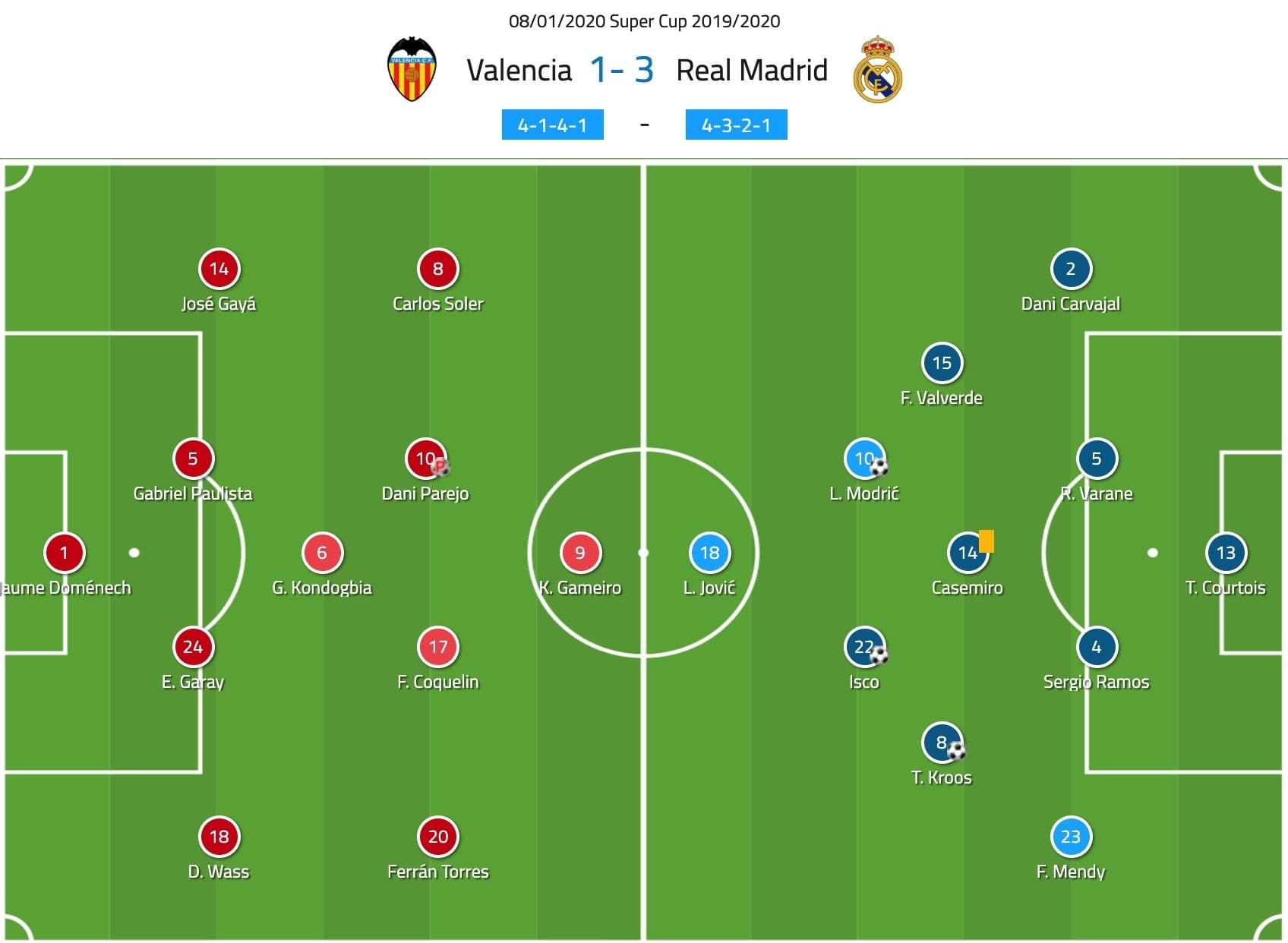
Valencia started the game in a rigid 4-1-4-1 system. At the base of the midfield sat the athletic Geoffrey Kondogbia. His role was to break up play as much as possible whilst blocking off direct passing lanes into Luka Jović. Ahead of him was Daniel Parejo and Francis Coquelin, they had equally as important jobs out of possession. The pair were heavily involved in blocking passing lanes into Luka Modrić and Isco, who were taking up awkward positions in the half-spaces. Kevin Gameiro took the lone position upfront. Throughout the game, he became very isolated as his team dropped deeper to close off spaces to their technically superior opponents.
Zinedine Zidane set his team up in a system designed to control the ball, a fluid 4-3-2-1. Casemiro occupied his usual role in the heart of the midfield, acting as the catalyst in possessional cycles. He would also look to shift play quickly by spraying balls left and right to the advanced full-backs Ferland Mendy and Dani Carvajal, who pushed higher in long spells of possession. Isco and Modrić took up more advanced positions, sitting just behind Jović in the half-spaces. It was their positioning that gave the Valencia midfielders a torrid time and allowed Madrid to dictate the tempo for the 90 minutes.
The tactical story
Some games take a while to find their rhythm, however, from the first whistle this game fell into its natural tactical pattern.
Valencia started with the strategy of creating a robust, deeper set structure, with the idea of making it difficult for their opponents. The centre-backs held a deep line, which was protected by a narrow midfield three positioned in front of them. This reduced space between the lines restricted time for the two attacking playmakers Isco and Modrić.
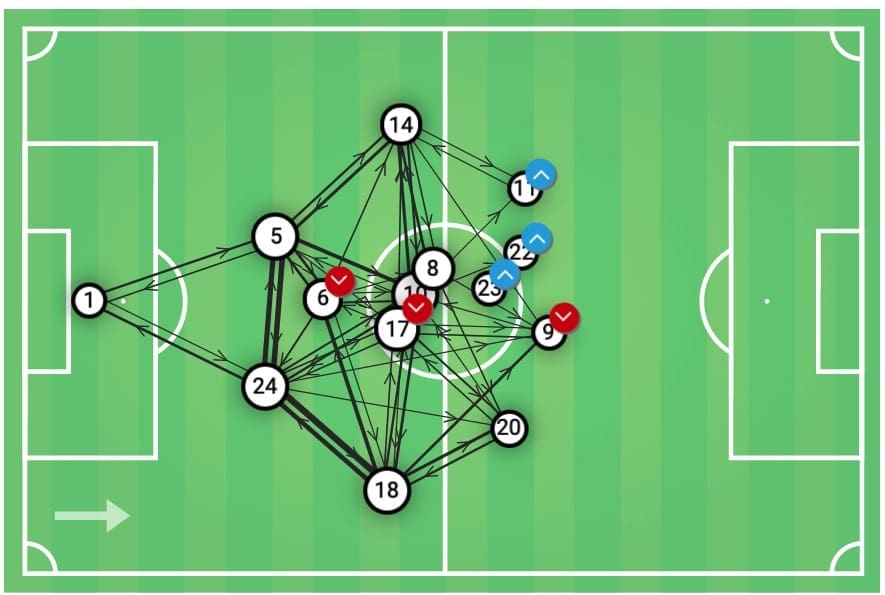
With a passive system in place, any attacking impetus was sacrificed. The abilities of Dani Parejo were restricted by the need to keep a narrow, congested midfield. A PPDA of 22.65 clearly demonstrates Los Ches’ gameplan. We can see below how close Parejo (10) and Coquelin (17) needed to stay in order to effectively block passing lanes through the spine of the pitch.
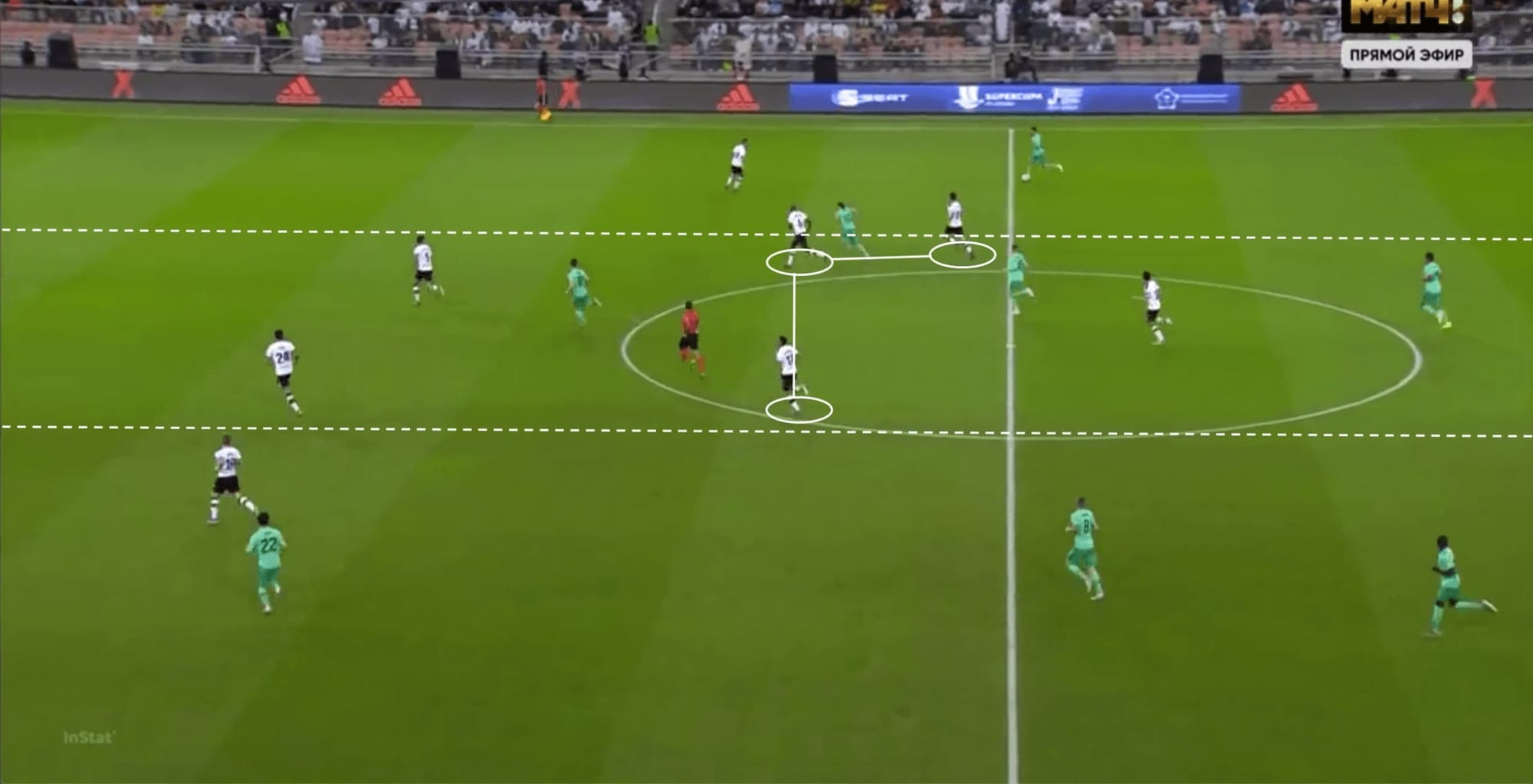
In the short spells of possession they did achieve, Valencia looked to go direct to Gameiro. They achieved an average pass per possession of just 4.85 as they attempted to transition quickly and hurt Madrid on the counter. This was ineffective as the vertical spaces between Gameiro and the midfield line had become too vast, making it a tough task for the Frenchman to take on the Madrid defence on his own.
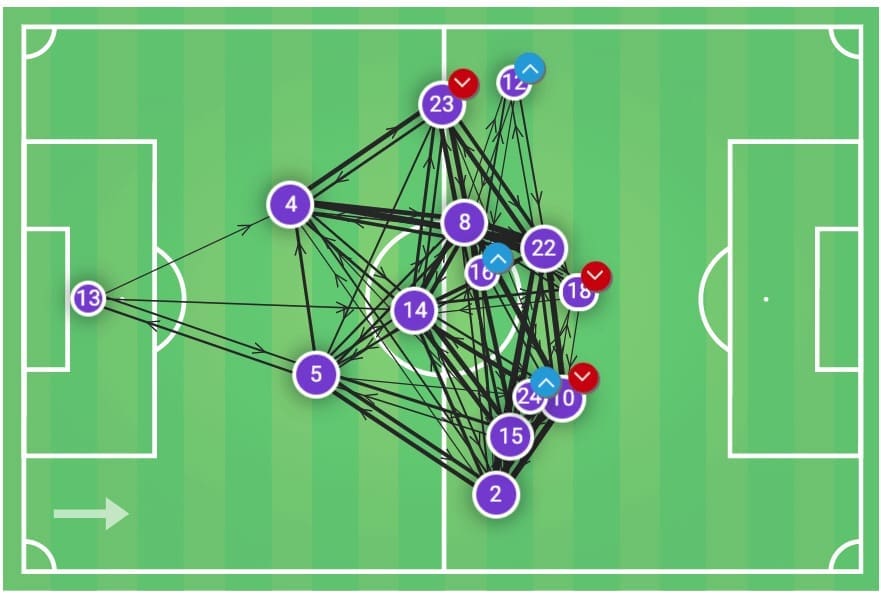
Madrid came with a different tactic. They sought to reduce transitions by dominating possession at a measured, methodical tempo. Los Blancos averaged 8.37 passes per possession which demonstrated their intent to unpick the resilient Valencia shape by using fluid passing combinations and create overloads which we look at later.
The full-backs of Madrid were liberal in their movement, using width to ply the spaces in the half-spaces open for Modrić and Isco to benefit. We can see how advanced Carvajal (2) and Mendy (23) operated, as their team camped safely inside the opposition half for the majority of the game. This advanced shape not only provided natural width but offered the opportunity to stretch Valencia by using longer switches of play, which players like Toni Kroos can hit with consummate ease.
In order to have lots of possession, you must be effective at recovering possession. Madrid were exactly that. They operated a well-organised, high man-to-man press that quickly suffocated any semblance of Valencia possession and recovered the possession. As a result, they could focus their attention on breaking down their opponents using overloads, which we look at below.
How Madrid kept the ball
Madrid’s tactics enabled them to dominate the ball for longs spells and eventually grind down their opponents. Their shape is directly linked to the deficiencies of Valencia’s as the mismatch in the two systems favoured the European giants.
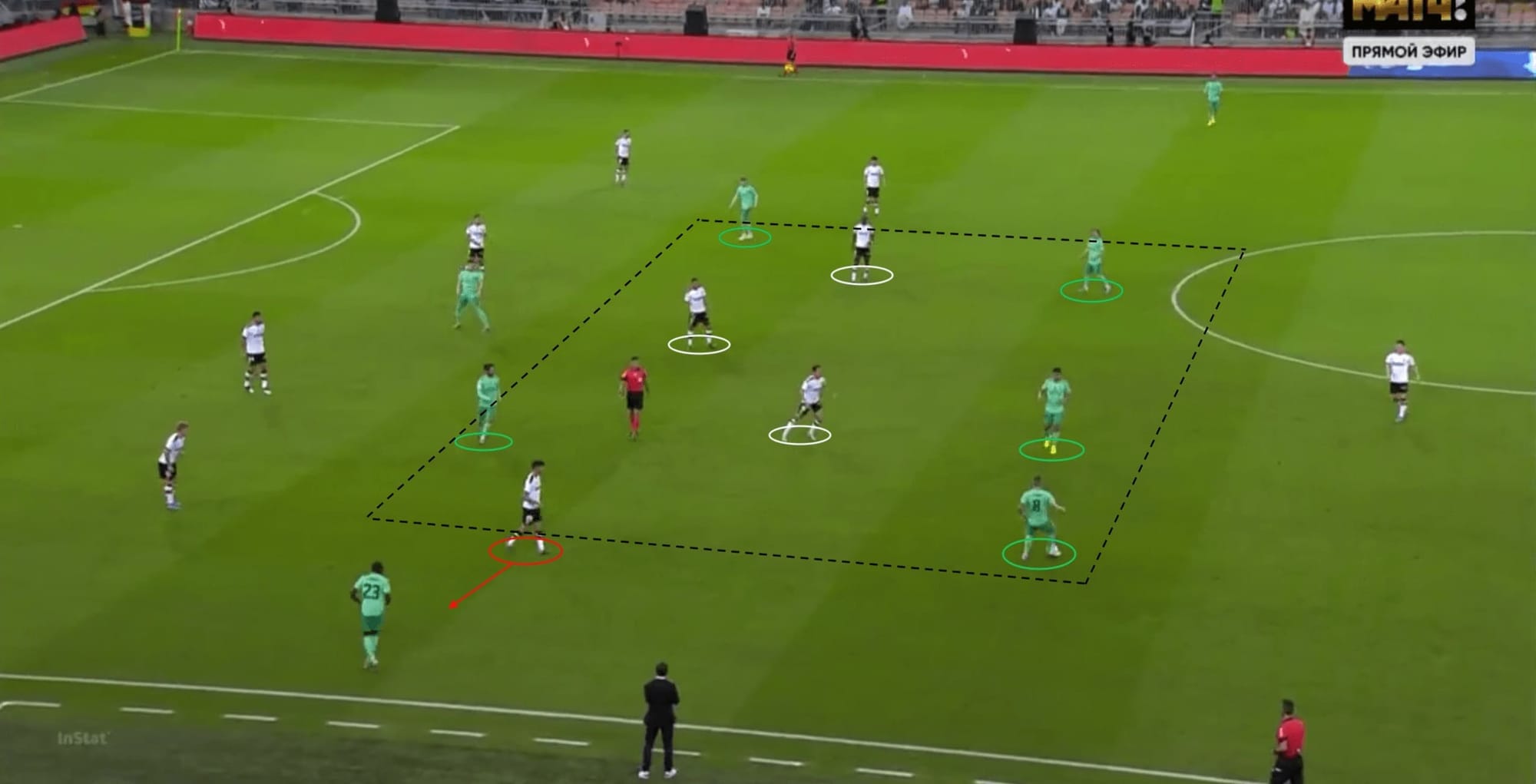
Zidane’s enforced shape created overloads all over the pitch that allowed Madrid to keep possession with ease. Above we can see Madrid in an advanced possession, inside their opponents half. Valencia have taken up their structured shape that appears safe. We can see, however, Madrid have actually created a 5v3 in a dangerous area of the pitch.
Despite tucking their wide players in, Carlos Soler and Ferran Torres cannot make up the deficit in the middle of the park as they are required to protect the passing lane into Madrid’s full-backs. By handicapping the Valencia wide men in this way, Madrid dominated in the central areas of the field.
This scenario constantly gave the Valencia midfielders a conundrum. We can see above how currently their decision is to remain passive by blocking the dangerous passing lanes into Isco and Modrić. However, this allowed Madrid easy possession and put no pressure on the ball.
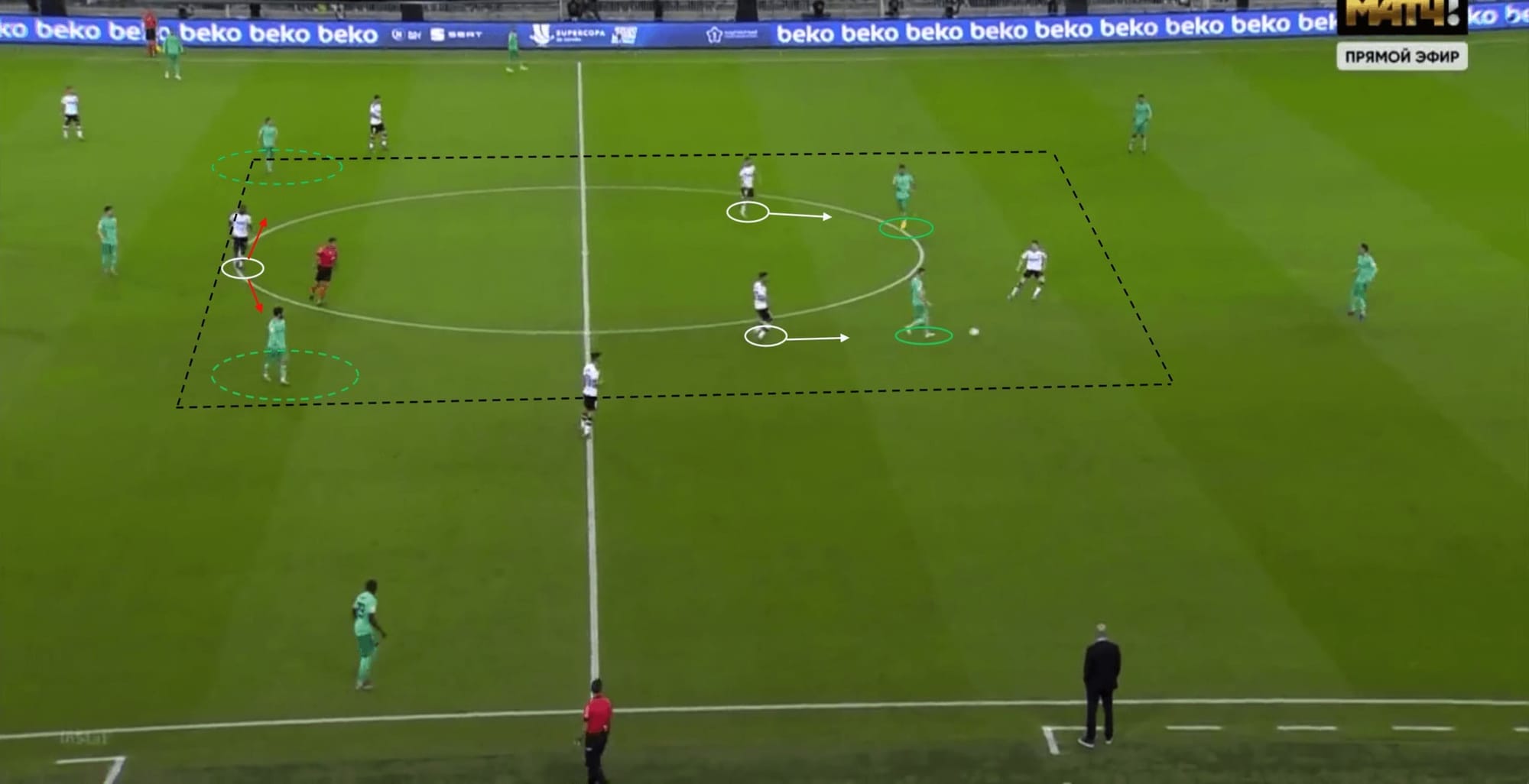
The alternative is for Perejo and Coquelin to push out and be more aggressive in their search to make a recovery, as we see them attempt above. This created more problems for the coastal side as it stretched their solid shape vertically, making it easier to penetrate.
We can see above, how the midfield two of Valencia have moved out to close down Kroos and Casemiro in possession. The effects of this are immediately obvious. The 5v3 has been stretched, opening easy passing lanes for Madrid into their dangerous players. When this situation occurred, notice how Jović, dropped slightly to occupy Kondogbia who is now completely overloaded. The wide men of Valencia are still in the same situation where they have to prevent easy passes into the advanced full-backs, so again, they cannot assist.
It was this creation of overloads that led to Madrid dominating their opponents with ease. It was only a matter of time before the first goal came, and it did come. An audacious attempt from Kroos directly from a corner gave the 13-time European champions the first goal and it was a lead they never looked like squandering.
A solution?
Valencia were poor in reacting to this constant barrage of attacks by their opponents and did little to adjust, making it a one-way affair for the majority of the game. One option Albert Celades may have considered making is explained below.
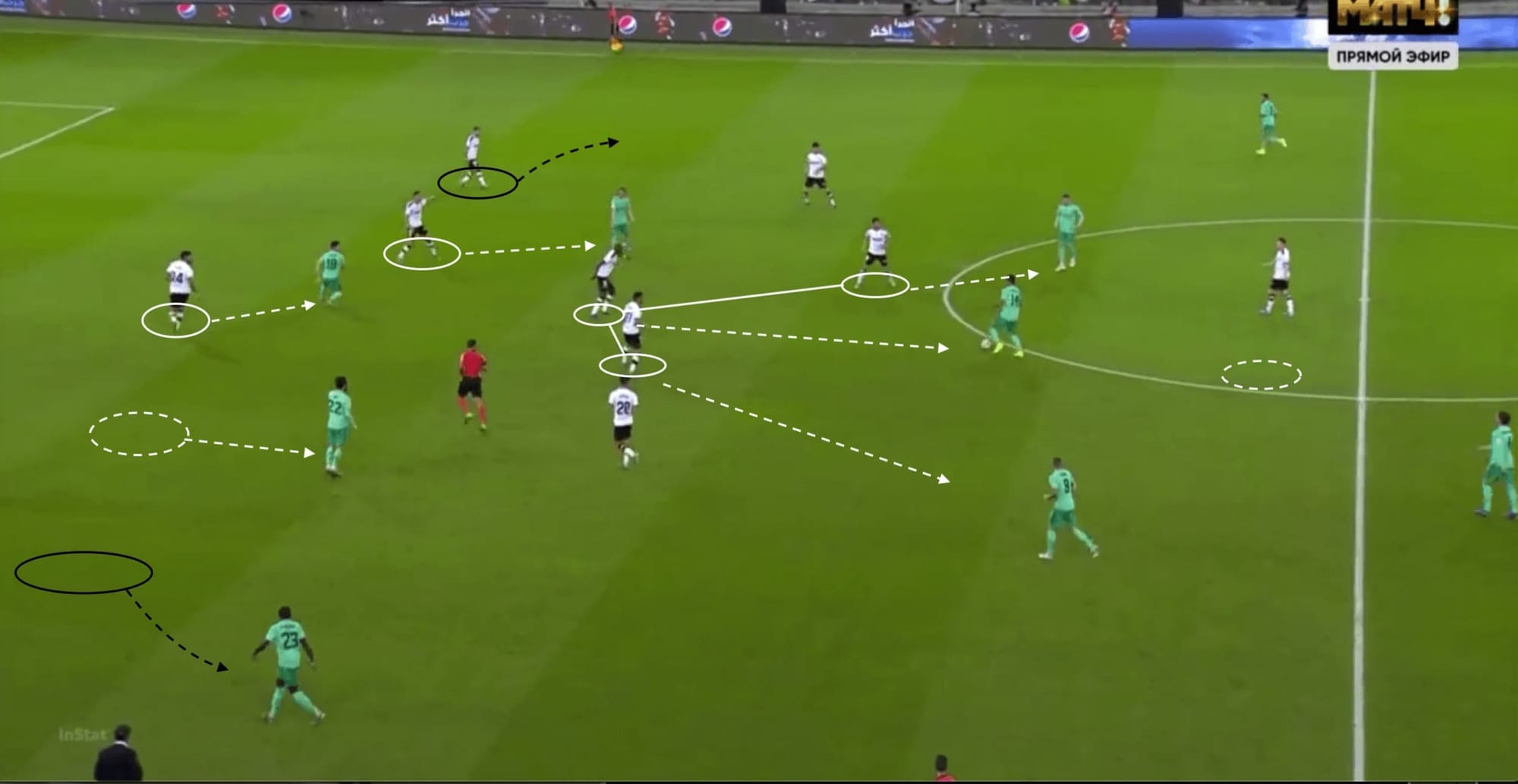
Valencia could have altered to a 5-3-2 system that would have prevented being continuously overloaded. The additional centre-back (highlighted by the dotted white circle) would have allowed the centre-backs to push up onto the attacking three of Madrid – who aren’t particularly quick, so being caught in behind was unlikely. The wing-backs in this system (black) would have been able to confront the full-backs 1v1 and prevent danger from occurring in the wide areas.
The original midfield three could have remained, however with the protection of the centre-backs who are now covering Isco, Modrić and Jović, they, in turn, can be more aggressive and pressure the Madrid midfield three who were dominating the ball.
This system would have eradicated the wide players from the equation who were ineffectual for large parts of the game and replaced them with an additional striker who could have supported Gameiro in transition and potentially caused Madrid a problem on the counter.
This approach, however, never formalised as Valencia allowed their opponents to cruise to a comfortable 3-1 victory.
Conclusion
Despite being underdogs, Valencia will be disappointed with the outcome of this match. Their tactical approach gave rise to problems on the pitch that were visible almost immediately. However, they struggled or refused to adjust in search of victory. Instead, their passive approach never looked like beating a side who were superior to them all over the pitch. One to forget for Celades and his men who will return to the La Liga to continue in their quest for a top-four spot.
Zidane flexed his tactical muscles once again, and it worked to perfection. The Frenchman saw his side dominate the ball and the entire match as they cruised into the final against Atlético. Sunday will be a different proposition for Los Galacticos, but be sure to see another clever system implemented in an attempt to give them a tactical advantage over their opponents.




Comments